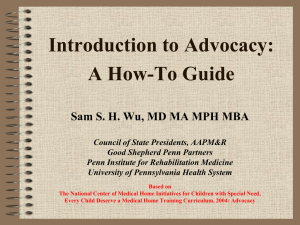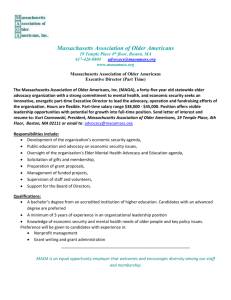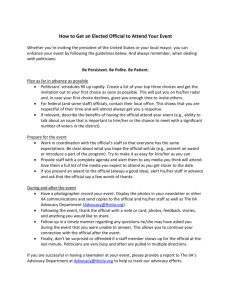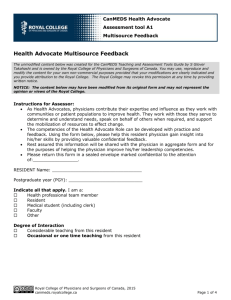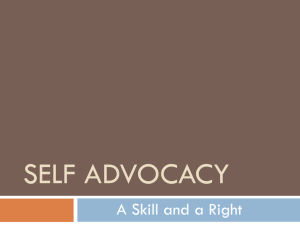MS Word - CanMEDS Interactive
advertisement
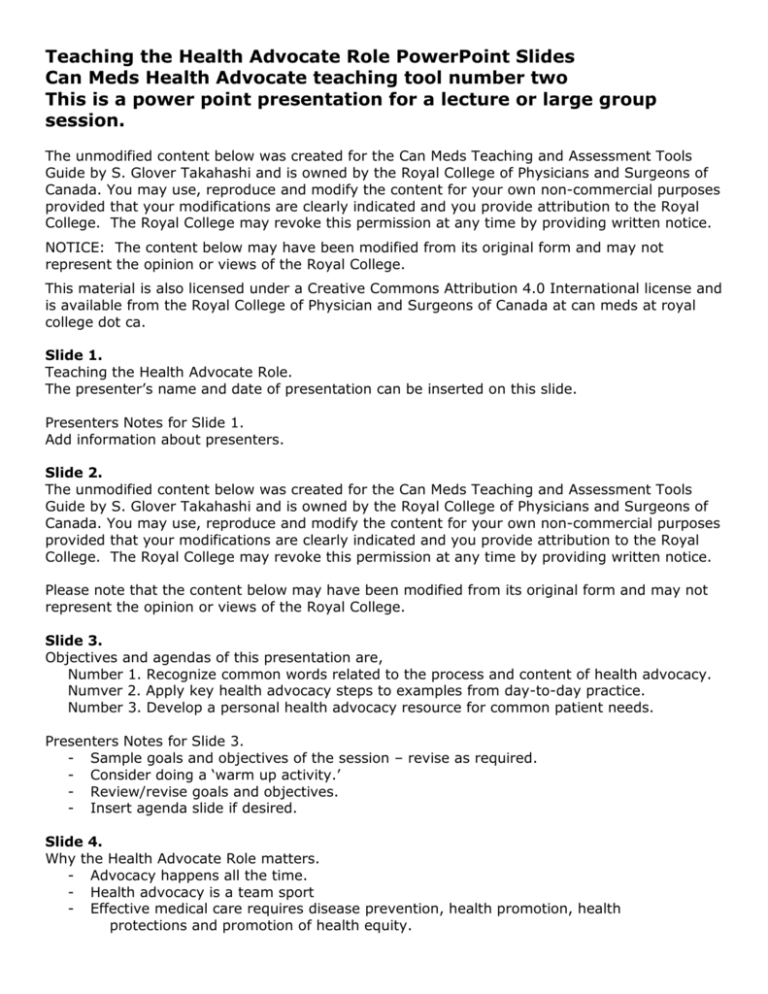
Teaching the Health Advocate Role PowerPoint Slides Can Meds Health Advocate teaching tool number two This is a power point presentation for a lecture or large group session. The unmodified content below was created for the Can Meds Teaching and Assessment Tools Guide by S. Glover Takahashi and is owned by the Royal College of Physicians and Surgeons of Canada. You may use, reproduce and modify the content for your own non-commercial purposes provided that your modifications are clearly indicated and you provide attribution to the Royal College. The Royal College may revoke this permission at any time by providing written notice. NOTICE: The content below may have been modified from its original form and may not represent the opinion or views of the Royal College. This material is also licensed under a Creative Commons Attribution 4.0 International license and is available from the Royal College of Physician and Surgeons of Canada at can meds at royal college dot ca. Slide 1. Teaching the Health Advocate Role. The presenter’s name and date of presentation can be inserted on this slide. Presenters Notes for Slide 1. Add information about presenters. Slide 2. The unmodified content below was created for the Can Meds Teaching and Assessment Tools Guide by S. Glover Takahashi and is owned by the Royal College of Physicians and Surgeons of Canada. You may use, reproduce and modify the content for your own non-commercial purposes provided that your modifications are clearly indicated and you provide attribution to the Royal College. The Royal College may revoke this permission at any time by providing written notice. Please note that the content below may have been modified from its original form and may not represent the opinion or views of the Royal College. Slide 3. Objectives and agendas of this presentation are, Number 1. Recognize common words related to the process and content of health advocacy. Numver 2. Apply key health advocacy steps to examples from day-to-day practice. Number 3. Develop a personal health advocacy resource for common patient needs. Presenters Notes for Slide 3. - Sample goals and objectives of the session – revise as required. - Consider doing a ‘warm up activity.’ - Review/revise goals and objectives. - Insert agenda slide if desired. Slide 4. Why the Health Advocate Role matters. - Advocacy happens all the time. - Health advocacy is a team sport - Effective medical care requires disease prevention, health promotion, health protections and promotion of health equity. Presenters Notes for Slide 4. Reasons why this Role is important. Slide 5. The details: What is the Health Advocate Role. As Health Advocates, physicians contribute their expertise and influence as they work with communities or patient populations to improve health. They work with those they serve to determine and understand needs, speak on behalf of others when required, and support the mobilization of resources to effect change. Presenters Notes for Slide 5. - Definition from the CanMEDS 2015 Physician Competency Framework - Avoid including competencies for learners - If you are giving this presentation to teachers or planners, you may want to add the key and enabling competencies (slides provided below). Slide 6. Determinants of health. - Determinants of health are the social and physical factors that impact the health outcomes of people and populations. - Learners who understand the determinants of health understand that the health of individuals is closely related to the broader community and environmental context in which they live. Presenters Notes for Slide 6. - Insert definitions, descriptions, and URL - Determinants of health are the conditions in which we live and work that impact the health outcomes of people and populations. - Provide examples of social and physical determinants of health. Slide 7. Recognizing Health Advocate process - Advise - Assist - Empower - Encourage - Facilitate - Influence - Justify - Liaise - Navigate - Negotiate - Recommend - Support. Presenters Notes for Slide 7. Trigger words relating to the process of Health Advocate Slide 8. Recognizing Health Advocate content - Access - Barriers Competing needs Health behaviours Health promotion Health literacy Literacy Policy Poverty Prevention Risk factor modification Safety Social environment Surveillance Presenters Notes for Slide 8. Trigger words relating to the content of Health Advocate Slide 9. What is Health Advocacy - Advocacy is not an action of an individual physician; rather, it is a shared process done in collaboration with the patient and with other health care providers or individuals. - Many clinicians will identify with advocacy as “agency,” which entails working within the system day to day to meet the health needs of a specific patient or community. - An explicit discussion using discipline- specific examples will help learners navigate the overlap in interests between the competencies of the Health Advocate Role and the stewardship competencies of the Leader Role. Presenters Notes for Slide 9. - These are the ‘answers’ to the misconceptions. Slide 10. Guided reflection and discussion Teaching Tool T3. Presenters Notes for Slide 10. Do a learning activity - Worksheet T3 from the CanMEDS Teaching and Assessment Tools Guide Health Advocate Role chapter is suggested. Title: Guided Reflection and Discussion: Recognizing health advocacy in day-to-day practice - Can do on own or in groups - Groups are appropriate when everyone is in the same specialty as examples will vary with each specialty - Explore answers in small groups or with the whole group Slide 11. Key process steps in health advocacy 1. Establish an understanding of the patient’s preferences, needs, strengths, and values for health care. 2. Collaborate with the patient, other health care professionals, and/or health promotion organizations. 3. Develop the action plan with the patient, other health are professionals, and/or health promotion organizations to help the patient achieve their self-identified goals. 4. Implement the agreed-to plan (i.e. by supporting, following, or on occasion leading, as appropriate). 5. Maintain open communication with the patient, other health care professionals, and/or health promotion organizations. Presenters Notes for Slide 11. Insert the five steps. - Explore each of the steps with the whole group. - Explore how to prepare for, act on, and evaluate each step in your specialty, based on experience — you can draw on either learners’ or teachers’ experience. Slide 12. Putting health advocacy into action. 1. Advocacy for services or resources. 2. Advocacy for healthy behaviours. 3. Advocacy for prevention, promotion, surveillance. Presenters Notes for Slide 12. - Consider focusing each session on one or two of the topics. - Consider focusing each session on one or a small number of patient issues. - Orient learners to these issues and explore them with the whole group. Slide 13. Small Group Activity Presenters Notes for Slide 13. Do a learning activity - Teaching Tool T4: Small group learning: Inventorying and evaluating your health advocacy in day-to-day practice, from the CanMEDS Teaching and Assessment Tools Guide, Health Advocate chapter is suggested. Slide 14. Health advocacy in day-to-day practice Presenters Notes for Slide 14. - Provide a personal example of when, where, and how to do health advocacy in day-to-day practice - Offer hints and tips for success from your personal experience based on situations that went well for you, or offer personal lessons you learned from your missteps Slide 15. Guided reflection and discussion. Presenters Notes for Slide 15. Do a learning activity - Teaching Tool T5: Guided Reflection and Discussion: Health advocacy resources for use in day-to-day practice from the CanMEDS Teaching and Assessment Tools Guide, Health Advocate chapter is suggested. Slide 16. Tips for teaching health advocacy 1. Provide resources about health advocacy needs of the communities and populations you serve. 2. Start a conversation about health advocacy. 3. Model health advocacy. 4. Signpost when you start to act as an advocate. 5. Help learners recognize advocacy needs 6. Create opportunities for learners to act as advocates. Presenters Notes for Slide 16. - Explore each of the hints with the whole group. - Explore how to prepare for, act on, and evaluate each hint in your specialty, based on experience. Slide 17. Tips for assessing health advocacy 1. Assess in a clinical setting with the help of other health professionals. 2. Include health advocacy in case presentations, case reports and rounds. 3. Assess how your learners are balancing the needs for health advocacy. Slide 18. Objectives and agenda 1. Recognize common words related to the process and content of health advocacy. 2. Apply key health advocacy steps to examples from day-to-day practice. 3. Develop a personal health advocacy resource for common patient needs. Presenter Notes for Slide 18. - Revisit workshop goals and objectives Slide 19 References for this presentation are. - Sherbino J, Bonnycastle D, Côté B, Flynn L, Hunter A, Ince-Cushman D, Konkin J, Oandasan I, Regehr G, Richardson D, Zigby J. Health Advocate. In: Frank JR, Snell L, Sherbino J, editors. CanMEDS 2015 Physician Competency Framework. Ottawa: Royal College of Physicians and Surgeons of Canada; 2015. Slide 20 forward are additional slides that may or may not be added to the presentation. Slide 21. Health Advocate Key Competencies. Physicians are able to: Key competency 1. Respond to an individual patient’s health needs by advocating with the patient within and beyond the clinical environment. Key competency 2. Respond to the needs of the communities or populations they serve by advocating with them for system-level change in a socially accountable manner. Presenter Notes for Slide 21. - Key Competencies from the CanMEDS 2015 Physician Competency Framework - Avoid including competencies for learners - You may wish to use this slide if you are giving the presentation to teachers or planners Slide 22. Health Advocate Key Competency 1. Physicians are able to: 1. Respond to an individual patient’s health needs by advocating with the patient within and beyond the clinical environment. Enabling Competency 1.1 is Work with patients to address determinants of health that affect them and their access to needed health services or resources. Enabling Competency 1.2 is Work with patients and their families to increase opportunities to adopt healthy behaviours. Enabling Competency 1.3 is Incorporate disease prevention, health promotion, and health surveillance into interactions with individual patients. Presenter Notes for Slide 22. - From the CanMEDS 2015 Physician Competency Framework - Use one slide for each key competency and associated enabling competencies Slide 20. Health Advocate Key Competency 2. Physicians are able to: Respond to the needs of the communities or populations they serve by advocating with them for system-level change in a socially accountable manner. Enabling Competency 2.1 is Work with a community or population to identify the determinants of health that affect them. Enabling Competency 2.2 is Improve clinical practice by applying a process of continuous quality improvement to disease prevention, health promotion, and health surveillance activities. Enabling Competency 2.3 is Contribute to a process to improve health in the community or population they serve. Presenter Notes for Slide 20 - From the CanMEDS 2015 Physician Competency Framework - Use one slide for each key competency and associated enabling competencies



